Step-by-Step Guide to Growing Virginia 202 Tobacco
Lovers of quality tobacco understand that you won’t find better products harvested from your own garden beds. The Virginia 202 variety is so popular that it accounts for 70% of all tobacco grown. It is characterized by a low content of harmful resins and an unusual sweetish taste. And thanks to its bright color palette - from lemon to orange - Virginia is called sunny tobacco.
Today we will tell you how to grow Virginia 202 tobacco yourself.
What type of tobacco is this?
Tobacco belongs to the genus of perennial and annual plants the nightshade family, whose leaves contain nicotine.
Today's smoking Virginia 202 tobacco is the most common variety with low resin content and pleasant taste.
History of origin and distribution
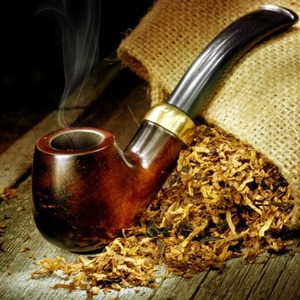 If you believe the legends of the North American Indians, tobacco became known to people several thousand years ago.
If you believe the legends of the North American Indians, tobacco became known to people several thousand years ago.
At that time he used not only for smoking, but also as medicine and even in religious rituals. And magical powers were attributed to tobacco smoke. It was believed that by inhaling smoke, a person talks to God.
Before the discovery of America, the plant was unknown to the world. It was brought from the New World to Europe by Christopher Columbus.
The crop (virginia tobacco) is named after the British colony of Virginia, where the first tobacco harvest was obtained in 1612. And since 1614, dried foliage from the colony was supplied to London.
This is interesting! Tobacco got its name from the island of Tabago, where nicotine plants grew.
To date Virginia 202 tobacco is grown all over the world with the exception of Antarctica.
Features, characteristics, description of the variety
The variety is intended for breeding in all climatic zones. Its main feature is the minimal content of harmful resins.
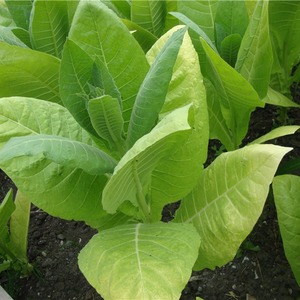 Plant color is light green, oval foliage, elongated, growing upward. The inflorescences are pale pink, medium in size.
Plant color is light green, oval foliage, elongated, growing upward. The inflorescences are pale pink, medium in size.
Productivity is good: one seedling forms up to 25 leaves 30-35 cm long. Thus, from 1 sq. m, up to 1.5 kg of products are collected. The taste is soft, delicate, sweet due to the high sugar content (up to 20%). The smoking resins have a light fruity aroma. Ideal for cigarettes and smoking pipes.
In addition to smoking, tobacco leaves are successfully used in cooking. Fragrant greens add an unforgettable sweetish-fruity flavor to meat and vegetable dishes. The leaves are also added to home canned food - not only for long-term preservation, but also for richness of taste.
This is interesting:
Where to buy and how much do seeds cost?
Virginia seeds can be purchased at gardening stores or online stores - there is a great demand for them. The cost of seed material depends on the manufacturer and varies between 100-300 rubles. There are 20 seeds in a package.
Features of cultivation
You can grow Virginia 202 tobacco only through seedlings. During the entire growing season, the plant grows a large number of stepsons.
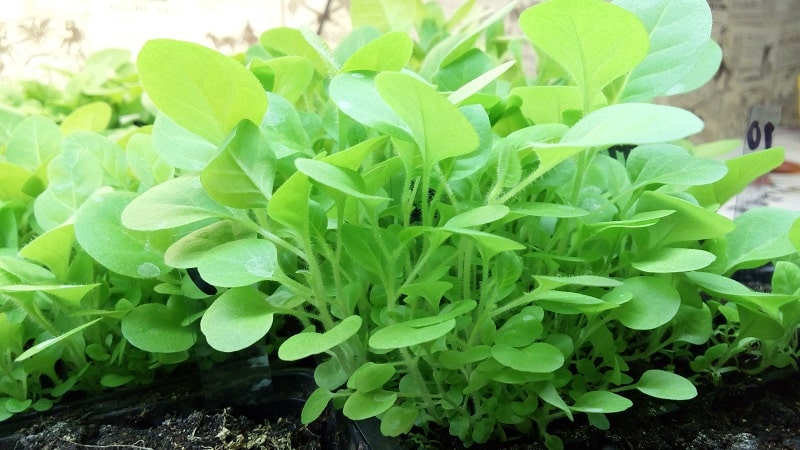
Condition requirements
Sowing of seeds begins at the end of March or early April. The seeds must be germinated, otherwise most of them will die in the ground. With insufficient lighting, the sprouts will stretch and weaken, which will lead to a decrease in plant immunity.
Preparation of soil and seed material, sowing seeds for seedlings
To germinate grains, place them on a piece of gauze., moistened with warm water, and put in a dark room for 1-2 days. As the gauze dries, moisten it with a spray bottle.
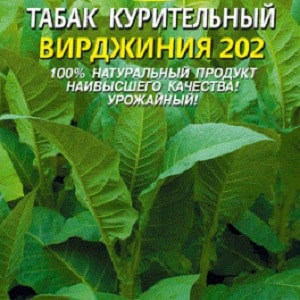 The soil can be purchased at a gardening store or prepared independently from turf soil and well-rotted humus in a ratio of 3:1. The prepared soil is spilled with a hot solution of potassium permanganate for disinfection. Then they spread the soil into planting containers.
The soil can be purchased at a gardening store or prepared independently from turf soil and well-rotted humus in a ratio of 3:1. The prepared soil is spilled with a hot solution of potassium permanganate for disinfection. Then they spread the soil into planting containers.
From containers Disposable plastic cups are most often used. They are pre-treated with a solution of potassium permanganate and small drainage holes are made at the bottom. Then small pebbles, sawdust or crushed eggshells are placed on the bottom for drainage.
Before sowing, water the soil warm, settled water, the seeds are carefully laid out on the surface, pressed lightly and sprinkled with soil on top. The seeded containers are covered with film and left indoors at room temperature.
Reference. When moisture stagnates, the risk of developing fungal infections increases.
First shoots and seedling care
First shoots appear in five days. At this moment, the film is removed, and the containers are immediately placed on the windowsill. Daylight hours for seedlings should be at least 13 hours. If the sunny day is shorter, additional lighting is installed, for example, fluorescent lamps.
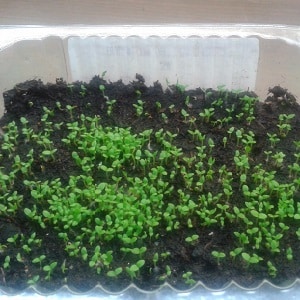 Moisten the soil as needed with warm, settled water from a shallow watering can.. The soil is kept moist, preventing it from drying out.After watering, it is loosened with an ordinary wooden stick.
Moisten the soil as needed with warm, settled water from a shallow watering can.. The soil is kept moist, preventing it from drying out.After watering, it is loosened with an ordinary wooden stick.
When 2-3 true leaves are formed, the seedlings are picked, transplanting into larger containers. The plant is considered unpretentious, so it easily tolerates picking. Two weeks after the procedure, the seedlings are fed with organic compounds or mineral fertilizers. From organic matter, chicken manure is used in a ratio of 1:10, and from mineral substances, nitrogen is used to increase green mass. If seedling growth is poor, additional fertilizing with chicken manure is carried out after two weeks.
A week before transplanting, the seedlings are hardened off. To do this, young plants are taken outside in the daytime, initially for an hour. Gradually, the time spent outdoors is increased to 8-9 hours.
Transplantation into the ground
Before planting seedlings in a permanent place, rotted compost is added to the soil. (per 1 sq. m. 1 bucket). When choosing a location for seedlings, consider corner areas. The main thing is that they must be protected from high humidity and drafts. Also, many gardeners plant seedlings along the fence.
The holes are placed at a distance of 25 cm from each other and a depth of 20 cm. Place a little compost at the bottom of each hole and moisten it. After transplanting, the beds are watered with warm, settled water.
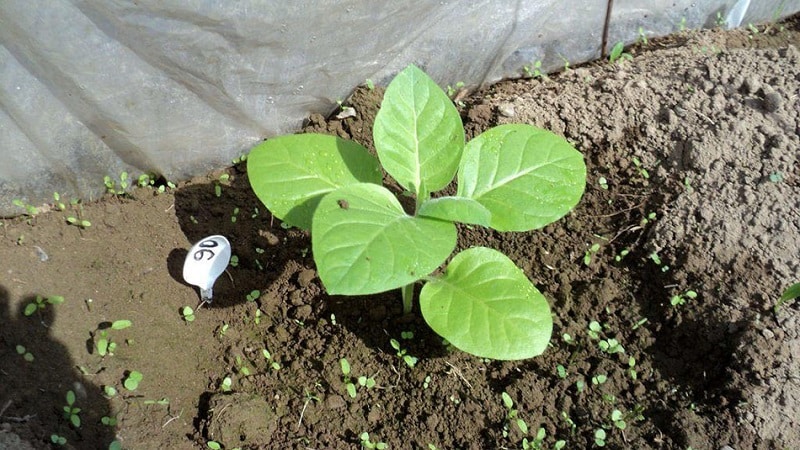
Further care for Virginia 202 tobacco
The frequency of watering depends primarily on the climate.where the crop grows. For the first three weeks, the plant is watered abundantly, but only with warm water. During heavy watering, monitoring the level of humidity in the beds is mandatory. When moisture stagnates, the volume and frequency of watering is reduced.
At the age of one month organic tissues of seedlings are born. During this period, they water every four days, the volume of moisture consumed is 10 liters per 1 square meter. m.
After two months the crop does not need large volumes of water, so watering is reduced.
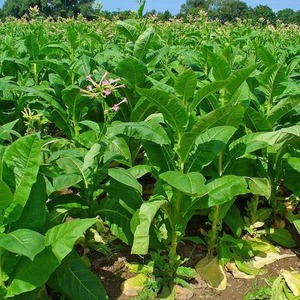 After watering, loosening and weeding are carried out. Many pests and fungal spores multiply in weeds, which increases the risk of diseases in plants.
After watering, loosening and weeding are carried out. Many pests and fungal spores multiply in weeds, which increases the risk of diseases in plants.
One week after transplant When placed in a permanent location, seedlings are fed with nitrogen to quickly gain green mass. This is an important step in tobacco care. Fertilizer is applied in the evening after watering.
During the ripening period, seedlings are fed with a full range of minerals. containing phosphorus and potassium. This feeding can be alternated with organic matter (chicken manure in a ratio of 1:10). At the time of ripening, the crop is fertilized at least twice.
About other types of tobacco:
Fragrant and tasty Havana tobacco for lovers of Cuban cigars
Diseases and pests
The culture is considered well resistant to diseases. However, the plant is not protected from powdery mildew and peronosporosis (downy mildew).
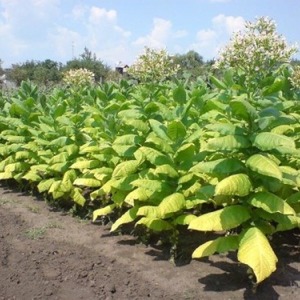 These diseases of fungal origin spread quickly in the warm season. First the leaves become diseased, and then the entire seedling. Up to 30% of plantings die. In the fight against dew, the drug “Zineb” is used. When treating, stop watering, as the fungus loves moist soil.
These diseases of fungal origin spread quickly in the warm season. First the leaves become diseased, and then the entire seedling. Up to 30% of plantings die. In the fight against dew, the drug “Zineb” is used. When treating, stop watering, as the fungus loves moist soil.
Tobacco thrips pest sucks juice from leaves, which negatively affects productivity. In addition, this insect carries many diseases. For prevention, it is necessary to remove all weeds, since weeds become the pest’s favorite habitat. When it appears, insecticides “Aktara” or “Karate” are used.
Reference. Thrips are a pest of four hundred plant species. Distributed throughout the Russian Federation.
Harvesting
Starting in mid-July harvesting and tobacco drying Virginia 202. Leaves are torn off from the lower tier, otherwise the leaf blade may be damaged.
The main disadvantage of the culture is that the leaves contain a large amount of chlorophyll (the pigment that gives the leaves their green color). For this reason, the foliage needs to turn yellow (dry) within 3-4 days. Simmering is carried out in conditions of high humidity (80-90%) and a temperature of 25-35°C.
Further processing
Before use tobacco is dried and fermented.
Drying
To dry, tobacco leaves are laid out on the surface in a layer no higher than 30 cm. and dry for 10-12 hours. After this, the foliage is given a vertical position (for example, hung on a rope). In warm and dry weather, the drying process does not exceed two weeks. After this procedure, store the dried foliage only in a pile.
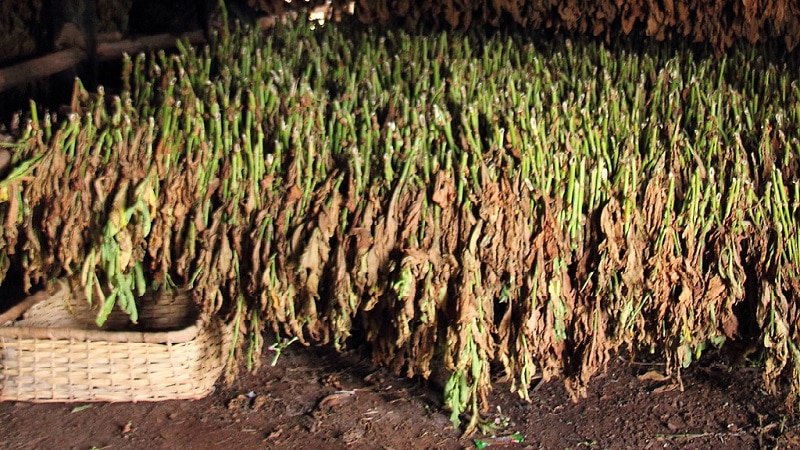
Fermentation
Fermentation is carried out to reduce nicotine content. This procedure is the final one in the processing of tobacco products, after which it is ready for use.
For the fermentation of Virginia 202 tobacco, two conditions are required: temperature +50°C and humidity 50%.
The easiest way is to use a microwave. The dried leaves are placed in jars and kept in the microwave for 30 minutes at the lowest power. When the jars have cooled to room temperature, the procedure is repeated twice more.
Advantages and disadvantages
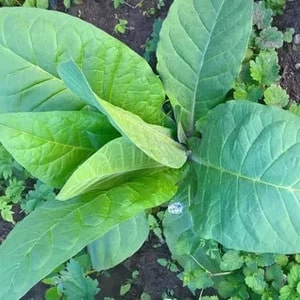 Let's start with the advantages:
Let's start with the advantages:
- ease of care;
- excellent yield;
- good disease resistance;
- possibility of breeding in all regions;
- low nicotine content;
- Possibility of use in cooking.
Negative characteristics include high chlorophyll content, which makes tobacco simmering necessary.
Reviews
Reviews of Virginia 202 tobacco are mostly positive. Everyone notes his unpretentiousness and excellent qualities.
Ivan, Dnepropetrovsk: “I love quality tobacco, so meeting Virginia is a kind of miracle for me. It’s easy to grow and what a result! I dry and ferment according to all the rules and enjoy the amazing taste.".
Yana, Tolyatti: “I decided to plant for the first time last year. Rather, for the sake of interest, grow something new at your dacha. The tobacco turned out amazing, I enjoy smoking it myself and treating it to my neighbor. Throughout the entire season, I fed the plant twice and watered it frequently. In general, care is not difficult, the seedlings did not suffer from anything.".
Conclusion
The Virginia 202 variety is indispensable for connoisseurs of real tobacco. Its unique sweetish taste with obvious fruity notes will satisfy any gourmet. Growing it is not difficult even for a beginner: the variety is characterized by excellent yield and resistance to diseases.